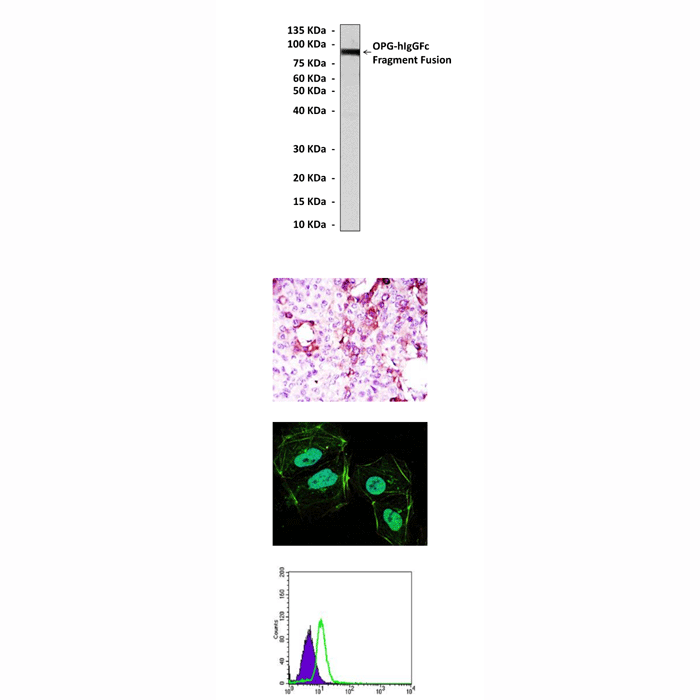Anti-OPG/TNFRSF11B: Mouse Osteroprotegerin/TNFRSF11B Antibody
Mouse OPG/TNFRSF11B Antibody: Mouse OPG/TNFRSF11B Antibody
Size: 100 ul
Price: $413.00
Description
The RANKL/OPG/RANK axis has been shown to regulate bone remodeling. RANKL is essential for osteoclast formation, function and survival and each of these activities are prevented by OPG. OPG has traditionally been linked to a number of bone-related diseases. However, there is additional evidence that OPG can promote cell survival by inhibiting TNF-related apoptosis-inducing ligand (TRAIL)-induced apoptosis. As a result, a number of in vitro, in vivo and clinical studies have been performed assessing the role of OPG in tumourigenesis. Similar studies have been performed regarding vascular pathologies, resulting from observations of expression and regulation of OPG in the vasculature.2 It has been demonstrated that RANKL/OPG/RANK system is linked to the development of atherosclerosis and plaque destabilization. RANKL exhibits several properties with relevance to atherogenesis, such as promotion of inflammatory responses in T cells and dendritic cells, induction of chemotactic properties in monocytes, induction of matrix metalloproteinase (MMP) activity in vascular smooth muscle cells (SMC), and RANKL has also been found to have prothrombotic properties. In observational studies, elevated circulating OPG levels have been associated with prevalence and severity of coronary artery disease, cerebrovascular disease, and peripheral vascular disease. Circulating OPG levels are increased in patients with acute coronary syndrome, and enhanced expression has been found within symptomatic carotid plaques. Elevated OPG levels have also been associated with the degree of coronary calcification in the general population as a marker of coronary atherosclerosis. OPG has been reported to predict survival in patients with heart failure after acute myocardial infarction, to predict heart failure hospitalization and mortality in patients with acute coronary syndrome, and to be associated with long-term mortality in patients with ischemic stroke. There are also a few studies that show a relationship between OPG and cardiovascular disease (CVD) and related mortality in the general population.3 Additionally the RANKL/OPG/RANK axis was found to be involved in central thermoregulation.4
2. Kiechl, S. et al: Expert Rev Cardiovasc Ther. 4:801-11, 2006
3. Caidahl, K. et al: Arterioscler Thromb Vasc Biol. 30:1684-6, 2010
4. Hanada, R. et al: Nature 462: 505–9,2009
Details
| Cat.No.: | CP10291 |
| Antigen: | Raised against recombinant human OPG/TNFRSF11B fragments expressed in E. coli. |
| Isotype: | Mouse IgG1 |
| Species & predicted species cross- reactivity ( ): | Human, Mouse, Rat |
| Applications & Suggested starting dilutions:* | WB 1:1000 IP 1:50 IHC 1:50 – 1:200 ICC 1:50 – 1:200 FACS 1:50 – 1:200 |
| Predicted Molecular Weight of protein: | 60 kDa |
| Specificity/Sensitivity: | Detects endogenous OPG/TNFRSF11B proteins without cross-reactivity with other family members. |
| Storage: | Store at -20°C, 4°C for frequent use. Avoid repeated freeze-thaw cycles. |
*Optimal working dilutions must be determined by end user.
